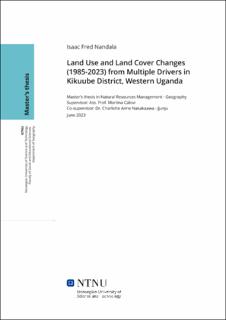| dc.description.abstract | Land use and land cover changes in nature are complex and are an outcome of land use practices in space and time. This study quantified land cover changes and the mechanisms in which land use practices interacted to contributed to land cover change in Kikuube district, western Uganda for a period of 38 years (1985-2023). Thus, understanding land use/land cover changes is vital in understanding the dynamic and complex global environmental change and sustainable land management. The maximum likelihood classifier supervised classification algorithm and the post classification categorical change detection method was used to quantify land use/land cover change patterns based on remotely sensed Landsat imagery for 1985, 1995, 2005, 2015 and 2023 using ArcGIS Pro software. A review of literature on historical developments in Kikuube district were also used to understand the nature of changes. Findings revealed that the largest decline rates across the study period were in woodlands at 0.24%, low stocked tropical high forests at 0.12%, plantation forests at 0.09%, and well stocked tropical high forest at 0.05%. The largest rate of increase per annum were in subsistence farmlands at 0.35%, commercial farmlands at 0.14%, and wetlands at 0.05%. Therefore, changes between natural and human induced land cover types were through afforestation, reforestation, deforestation and degradation for agricultural expansion, infrastructure development. It was also observed that LULC changes were largely outside protected areas shaped by terrain, population demographics and policy changes for oil exploration and development activities, refugees’ influx, and sugar cane growing expansion. On the other hand, NDVI min, max values (-0.027, 0.44 to -0.069, 0.5) revealed an increase in vegetation across the study period. A key contribution of this study was twofold; Firstly, LULC changes from major activities and how they interact across space and time and finally LULC changes before commercially viable oil reserves were declared. It is recommended that further research should focus on household perceived drivers of change and their implications of land use/land cover changes in Kikuube district. | |
